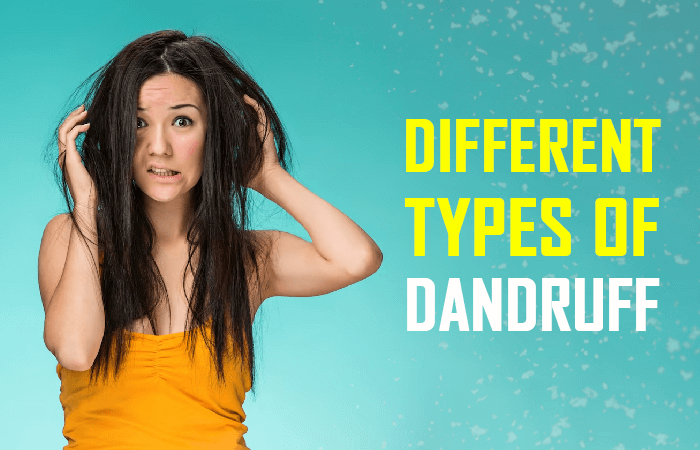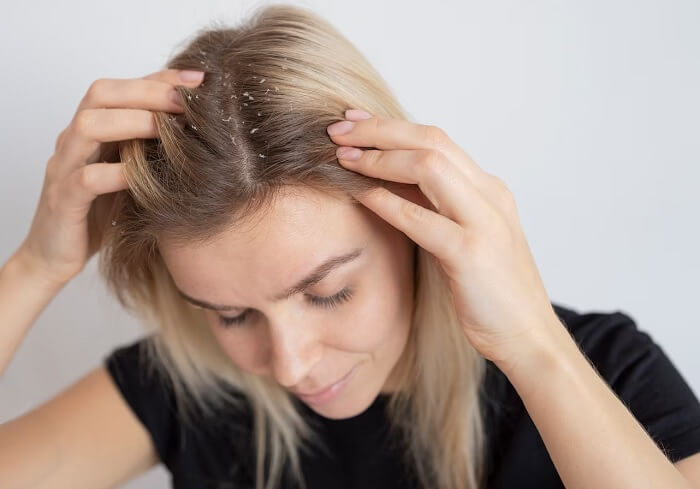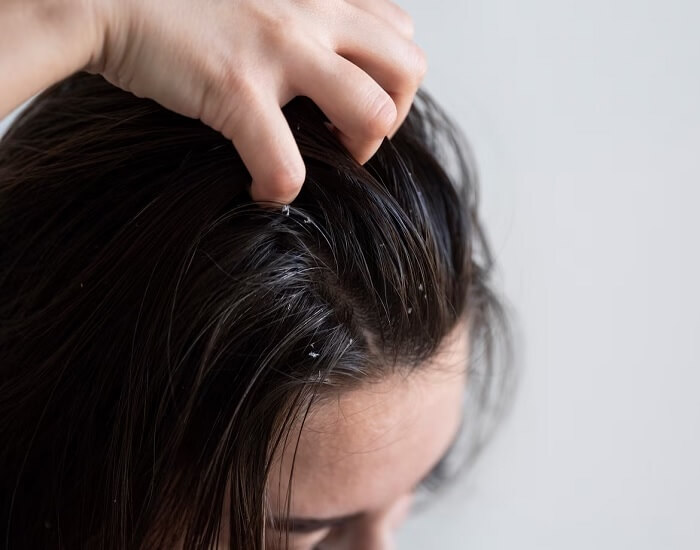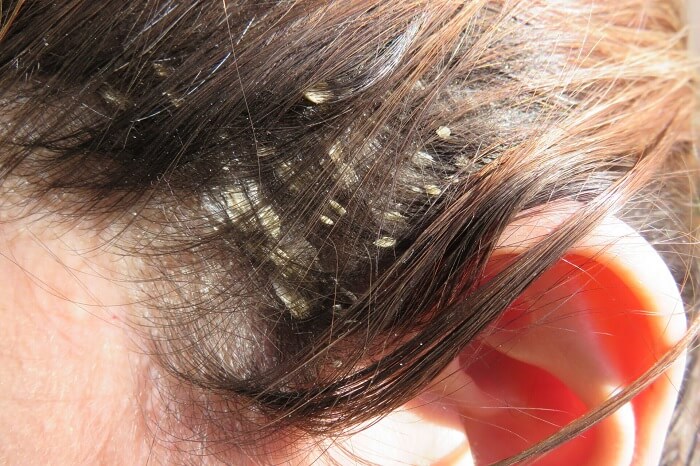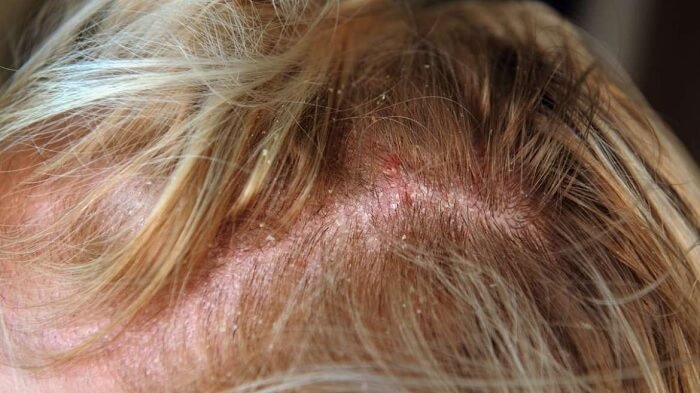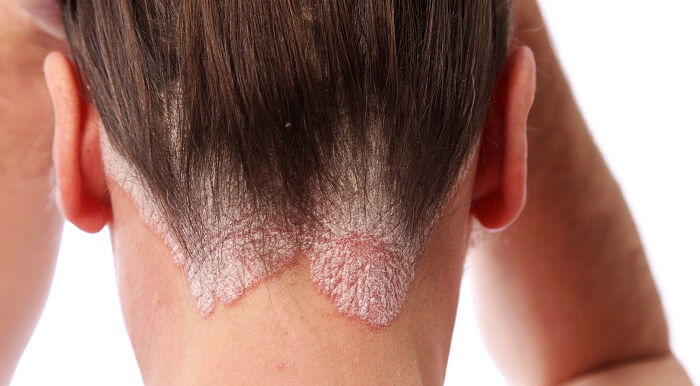Dandruff, like different types of hair and skin, can come in various forms. It shows up as white flakes in your hair and often comes with symptoms like redness and an itchy scalp. Dealing with dandruff can be frustrating, but the good news is that it can be treated. However, before you start treating it, it’s important to understand the different types of dandruff and how to take care of them. We’ll explain the types of dandruff and how to treat them.
Different Types Of Dandruff
There are different kinds of dandruff, and each one has a different reason why it happens. Some types can be treated easily by changing the way you take care of your hair or by using home remedies for dandruff. But there are other types of dandruff that need special medicines prescribed by a doctor.
Let’s learn more about the different types of dandruff and what causes them:
- Dry Skin-Related Dandruff
- Oily Scalp-Related Dandruff
- Fungal Dandruff
- Dandruff Caused By Product Buildup
- Dandruff Caused By Seborrheic Dermatitis
- Dandruff Caused By Psoriasis
1. Dry Skin-Related Dandruff
Dandruff is a common problem that often occurs in people who have dry scalps. Having a dry scalp can happen when the weather is very cold, like during winter, or when you don’t wash your hair regularly. People who have curly hair might experience a dry scalp more often compared to people with other hair types. Using shampoos that contain sulfates, which produce lots of foam, can make the problem of dry skin-related dandruff worse or cause it in the first place.
Appearance: Dry scalp dandruff flakes are tiny and white. They are the most common kind of dandruff.
Cause:
- During the cold winter months, your scalp may become dry and flaky.
- When you wash your hair with warm water, it can make your scalp dry and cause dandruff.
Symptoms:
- When the skin on your scalp gets very dry, it can cause irritation and make you feel itchy.
- The itchiness is not too strong, it’s more like a medium level of discomfort. It never gets really bad or intense.
2. Oily Scalp-Related Dandruff
This condition happens when your scalp becomes oily. Sometimes, your body makes too much natural oil called sebum. Normally, sebum helps keep your hair and skin moisturized and prevents them from drying out. It can also slow down some signs of aging. Sometimes, our body produces too much of an oily substance called sebum. This can happen when we’re going through changes like puberty, pregnancy, feeling stressed, or not washing our hair regularly. When this extra sebum combines with dirt and dead skin cells, it creates something called dandruff.
Appearance: Dandruff flakes from an oily scalp look bigger than flakes from a dry scalp. They are yellow in color and seem greasy.
Cause: When the glands beneath your scalp produce too much oily substance called sebum, it can make your scalp feel greasy. Sebum is a natural moisturizer that keeps your scalp skin healthy and hydrated.
Symptoms:
- When there is too much oil on your hair, it can block the tiny openings on your scalp and make your skin feel itchy and uncomfortable.
- When you have yellow patches on your scalp, it means there are areas where the skin looks yellowish. These patches can be accompanied by big flakes of dandruff that also have a yellowish color. Additionally, your hair may feel greasy or oily.
3. Fungal Dandruff
Fungal dandruff happens when you have a scalp infection caused by a fungus called Malassezia globosa. This infection can spread quickly if your scalp is very oily or has an imbalance in its natural pH level. The fungus produces a substance called oleic acid, which makes your skin cells shed more frequently, resulting in dandruff.
Appearance: Appears larger, greasy, and darker.
Cause: Malassezia, a fungus, is often responsible for this type of dandruff.
Symptoms:
- Excessive itching, inflammation, and eczema.
- White or yellowish flakes in your hair and your scalp feels itchy
4. Dandruff Caused By Product Buildup
If you use a lot of different products to style your hair, like leave-in conditioners, gels, serums, pomades, mousses, or hair sprays, they can build up on your scalp. This build-up can mix with dirt and dead skin cells and make dandruff. It can also make you lose hair.
Symptoms: Having big, white, or yellowish flakes on your scalp, feeling itchy or irritated, and experiencing hair loss.
5. Dandruff Caused By Seborrheic Dermatitis
Seborrheic dermatitis, also known as pityriasis steatoides, is a long-lasting skin condition that causes inflammation. It commonly occurs in areas of your body where there are more oil-producing glands, such as your scalp, neck, behind your ears, face, and eyebrows. Research indicates that scalp dermatitis often occurs due to an inflammatory response to yeast, which is naturally present on the surface of your skin. Factors such as stress and hormonal changes can activate seborrheic dermatitis.
Symptoms: Huge, white or yellowish dandruff flakes, scaly patches, greasiness, redness, and irritation.
Dandruff can be a big problem for some people. It can make you feel embarrassed, especially when you’re with other people. But you don’t have to worry too much because there are simple ways to treat dandruff. You can use special products or try natural methods to get rid of them.
6. Dandruff Caused By Psoriasis
Psoriasis is a long-lasting skin problem where the immune system mistakenly attacks the skin cells that are supposed to be healthy. This causes the skin to make new cells too quickly, and the old skin doesn’t have enough time to fall off normally. As a result, thick, silver-colored, and scaly patches appear on the scalp, neck, knees, and back.
Symptoms: Silver-colored scaly patches, thick white big flakes on the scalp, redness, and mild itching.
Tips To Prevent Dandruff
Dandruff treatment and prevention strategies can be divided into three different categories:
1. Dandruff shampoos
You can find many shampoos at the store that can help with dandruff. These shampoos are available without a prescription. They are made to treat dandruff and keep it from coming back. If you have a sensitive scalp, make sure to choose a shampoo that is gentle and doesn’t cause any irritation. Look for shampoos that have these ingredients in them:
- Ketoconazole: Ketoconazole is a medicine that you need a prescription to get. It is used to treat dandruff caused by a type of fungus. It is really good at getting rid of the fungus and stopping the dandruff.
- Salicylic acid: This is good for people with oily scalps who have dandruff. You can use it every day or two to three times a week.
- Selenium sulfide: Selenium sulfide is a substance that can fight against fungal infections. If you use shampoos containing selenium sulfide, it’s important to make sure you wash your hair very well afterward.
- Coal tar: It helps get rid of dead skin cells on the scalp, which reduces dandruff. However, it’s not recommended for people with light-colored hair.
- Zinc pyrithione: This product works well for all types of hair. It can help fight dandruff because it has properties that kill bacteria and fungi.
- Cyclopiroxolamine
- Luliconazole
2. Lifestyle
Taking care of your overall health can also help your scalp in many ways. Here are some simple things you can do:
- Taking care of your stress is important because when you’re stressed a lot, it can make your immune system weaker and make certain skin conditions like seborrheic dermatitis, eczema, and psoriasis worse.
- Make sure to eat a balanced and healthy diet with foods that contain lots of omega-3 fatty acids, zinc, B vitamins, and probiotics.
3. Hair care
If you often have dandruff, you might need to make some changes to how you take care of your hair and the products you use. Here are some things you can try to help with dandruff:
- Avoid using too many hairstyling products, such as hair dyes, that can make your skin itchy or leave oils and chemicals on your scalp. These things can make dandruff more likely to happen.
- Don’t use hot water. Instead, use warm water to wash your hair.
- Wash your hair often with a mild shampoo or a shampoo that helps fight dandruff, and make sure to rinse it well.
Home Treatments for Dandruff
You can treat dandruff at home using natural products you already have in your kitchen. But keep in mind that different types of dandruff might need different treatments:
1. Coconut Oil for Dry Scalp Skin Type Dandruff
Coconut oil has special proteins that help your hair grow healthy and make your scalp feel less dry. It also keeps your scalp moisturized, which stops dandruff from happening.
2. Tea Tree Oil for Fungal Infection-related Dandruff
A study published in the International Journal of Dermatology found that tea tree oil has powerful properties that can help reduce inflammation and fight against harmful microorganisms. These microorganisms include bacteria, fungi, and viruses that can cause infections. So, tea tree oil is effective in protecting against these types of infections.
To get the most out of tea tree oil for your scalp, apply it before bed and leave it on overnight. The next day, wash your hair with any regular or herbal shampoo.
3. Lemongrass Oil for Dandruff Resulting From Fungal Infection
Lemongrass oil is being researched because it might be able to stop the growth of a fungus called Malassezia, which causes dandruff. If you use a shampoo or hair tonic that contains lemongrass oil, it could help you feel better and reduce dandruff caused by this fungal infection.
A research study found that using a hair product called hair tonic with 10 percent lemongrass oil is very effective in treating dandruff caused by fungal infections.
4. Apple Cider Vinegar for Fungal Infection-related Dandruff
Researchers have found that apple cider vinegar has the ability to fight against fungi, which are tiny organisms that can cause problems like dandruff. This means that using apple cider vinegar might be helpful in treating dandruff caused by a fungal infection.
5. Baking Soda as an Anti-dandruff
Baking soda can help with dandruff because it has properties that can gently remove the extra dead skin flakes from your scalp. It also has substances that can stop or reduce the growth of a fungus called Malassezia, which is responsible for causing dandruff. So, using baking soda on your scalp can help get rid of dandruff and keep your scalp healthy.
Remember to use only a little bit of baking soda. Before putting it on your scalp, it’s a good idea to try a small amount first to see if it works well for you.
6. Eucalyptus Oil for Dandruff Resulting From Seborrheic Dermatitis
Research has shown that eucalyptus oil may help reduce inflammation. One way to use it is by mixing it with coconut oil and gently massaging your scalp with the mixture.
Using eucalyptus oil might help make your itchy scalp and redness caused by dandruff feel better. Researchers found that eucalyptus oil has substances that can fight against bacteria and fungi, which are the things that cause dandruff. This means that using eucalyptus oil may help improve the symptoms of dandruff.
7. Aloe Vera as an Anti-dandruff
Aloe Vera has lots of important vitamins like vitamin A, vitamin B, and vitamin C. Because of this, it can be used to make your scalp healthy and well-nourished. A study has shown that aloe vera is good for treating dandruff because it can moisturize a dry scalp.
When to See a Doctor
If you have a little bit of dandruff, you don’t need to see a doctor. But if you have a lot of dandruff and it makes your scalp very itchy and red, you should see a skin doctor. Sometimes, home remedies and treatments don’t work well enough for dandruff. In those cases, a doctor can give you special shampoo and tonic for your hair and scalp. You need a prescription from the doctor to get those.
If you have any of the following symptoms, you should see a doctor or a dermatologist:
- Redness and irritation that does not reduce or go away
- Continuous flaking of scalp skin
- Severe itchiness of the scalp
- Home treatments and over-the-counter (OTC) medicated shampoos produce no or little effect
- Excessive hair fall
- Scalp skin infections like psoriasis or eczema are present
- Pus from the scalp skin
- Foul smell from scalp and hair
FAQs
1. Does washing your hair every day lead to dandruff?
Washing your hair every day with shampoo can cause dandruff if your scalp is dry. If you have an oily scalp, using shampoo every day may not cause any problems. But you can still wash your hair every day with just water. Avoid using hot water because it can make your scalp dry and lead to dandruff. It’s important to use shampoo in moderation. You can try using a baby shampoo or herbal shampoo two or three times a week.
2. Can dandruff spread from one person to another?
Usually, dandruff doesn’t spread from one person to another. But if someone has dandruff caused by a fungal infection, it can spread to another person if they share towels to dry their hair. So it’s important not to share towels or clothes with someone who has dandruff caused by an infection. Otherwise, the dandruff might spread from one person to another.
3. How can you figure out what type of dandruff you have?
Dandruff flakes may look similar, but if you look carefully, you’ll notice differences based on different types. Dandruff can vary because of various reasons and scalp conditions. To understand what type of dandruff you have, you should pay attention to how the flakes look—like their color and size—and consider your skin and hair condition, along with any other symptoms you might have. This will help you figure out the specific type of dandruff you’re dealing with.
Rose Frank
Latest posts by Rose Frank (see all)
- Knitting with Rayon Yarn: Properties & Patterns - May 3, 2024
- Knitting with Polyester Yarn: Properties & Patterns - February 20, 2024
- Different Types of Fabric: Names of Cloth Materials - February 1, 2024
